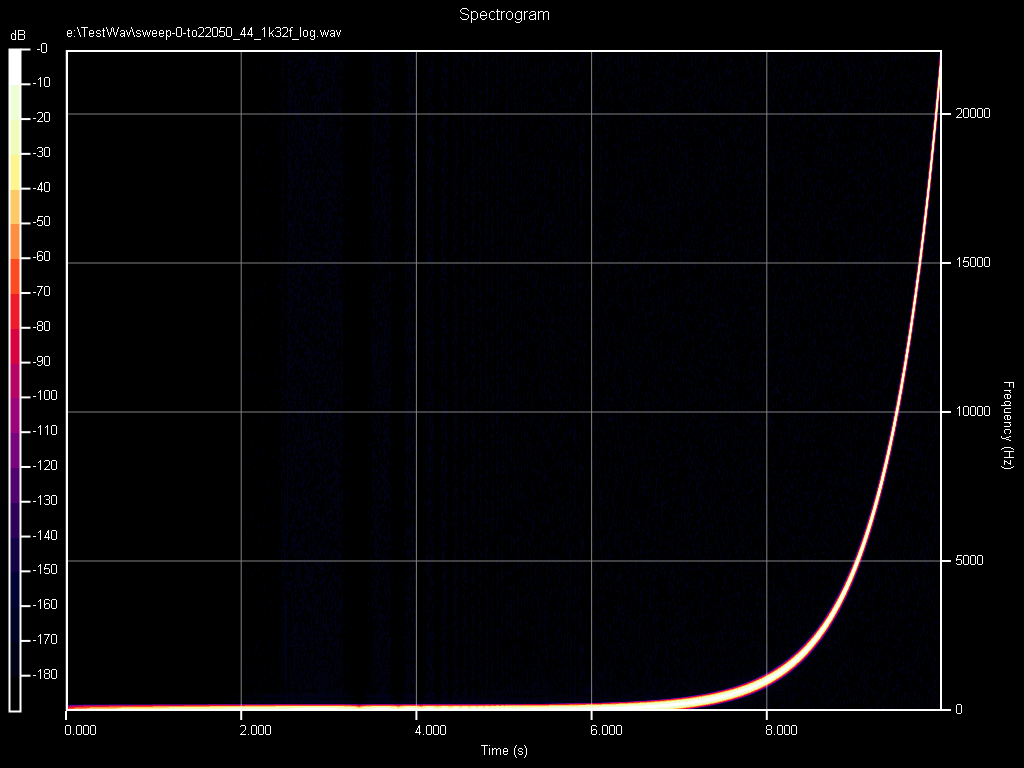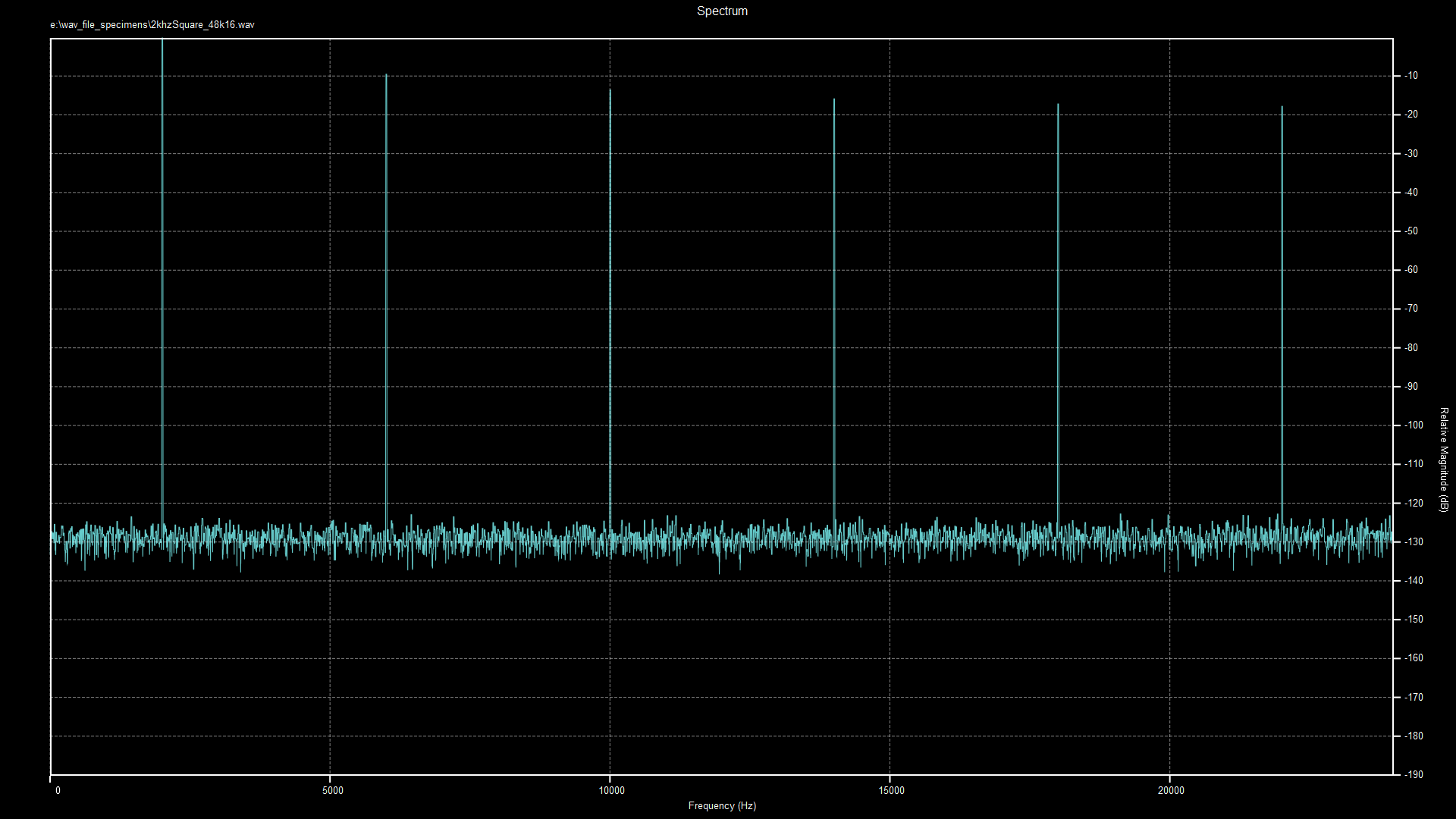soundfile-to-spectrogram / spectrum utility
 above: spectrogram showing 0-22050 Hz frequency sweep
above: spectrogram showing 0-22050 Hz frequency sweep
 above: frequency spectrum of 2khz square wave
above: frequency spectrum of 2khz square wave
sndspec filename [filename2 ...] [options]
Usage: sndspec filename [filename2 ...] [options]
--dyn-range <n> Set Dynamic Range in dB
-o, --output-dir <path> Set Output directory
-h, --height <n> Set Image Height in Pixels
-w, --width <n> Set Image Width in Pixels
-t, --time-range <start-time> <finish-time> Set Time Range in seconds
--white-background White Background (instead of black) with inverted colors
-W, --window <name> Set the window function
--show-windows Show a list of available window functions
--spectrum Plot a Spectrum instead of Spectrogram
-S, --smoothing <moving average|peak|none> Set Spectrum Smoothing Mode (default:peak)
-c, --channel <[all|[L|R|0|1|2|...]...] [sum|difference|normal]> select specific channels and set channel mode
-r, --recursive Recursive directory traversal
--version Show program version
--help Help
- generate a spectrogram for the first 10 seconds of the left channel only of each sound file in the folder e:\songs and put the output images in the folder e:\spectrograms
sndspec "E:\songs" --width 1024 --height 768 --dyn-range 190 -o e:\spectrograms -t 0 10 --smoothing peak --channel left
- create a spectrum analysis for the file "2khz_square_wave.wav" using a blackman-harris window for the time range 00:00:00.5 - 00:00:01.0
sndspec "E:\samples\2khz_square_wave.wav" --width 1920 --height 1080 -o e:\spectrums -t 0.5 1.0 -W blackmanharris
- generate a spectrogram of the sum of all channels in each file in the directory ~/soundfiles AND its subdirectories, and place the output spectrograms in the folder /tmp/spectrograms
sndspec ~/soundfiles -r --channel sum -o /tmp/spectrograms
- generate a spectrum analysis of the difference of the channels (ie L - R) in the file ~/soundfiles/guitar.flac, and place the output in the same directory as the source
sndspec --spectrum ~/soundfiles/guitar.flac --channel difference
- input filenames can be either directories or files. If they are directories, all suitable files within them are processed. Combinations of files and directories are ok.
- if recursive directory traversal is enabled, directories within directories will also be processed
- case and punctuation of window names is ignored. Kaiser window is the default, and it is tuned to the requested dynamic-range
- output filename is input filename with .png extension
- when plotting a spectrum, a single FFT is performed, so the time range must be reasonable to prevent FFT being too large. (Therefore, don't forget to put in a sensible time range to ensure the FFT is not too large)
- if you want to plot the frequency response of an impulse response, you might want to switch-off the default Kaiser Window, by using -W rectangular, particularly if your impulse response is asymmetrical, as the window might skew your results in an undesirable way.
- Smoothing option only applies to spectrums
- when specifying channels with the --channel option, the left channel is 0 and the right is 1. Channels always start at zero.
- The default channel setting is all channels / normal mode
- For spectrograms in normal mode, the first enabled channel is plotted. (use --channel R to get a spectrogram of the right channel)
- sum / difference modes operate on all channels regardless of requested channels (this may be fixed in a future release)
- default dynamic range is 190 dB
- command line options can be placed in any order
Having used the spectrogram tool from sndfile-tools for testing ReSampler for some time, I wanted to improve upon the method of generating spectrograms (and spectrums) in the following ways:
- directory traversal : allows processing a whole directory (and subdirectories, if desired) of sound files without having to rely on scripts
- speed : by processing sound files in batches, the overhead of starting up the program and initializing resources can be done just once, thereby saving a lot of processing time
- ability to plot spectrums (in addition to spectrograms)
- ability to choose from a variety of window functions
- core functions in a library component, to be used in other future software projects
- potential quad-precision (or long double) implementations
- potential customisation of color palettes and targeting of paper formats as well as screen
- potential plotting of cepstrums and other types of transforms / plots
Although the produced plots bear a strong resemblance to those produced by the sndfile-tools spectrogram program, the code for sndspec is entirely original.
#install dependencies
sudo apt install libsndfile-dev
sudo apt install libfftw3-dev
sudo apt install libcairo-dev
#build
cd directory-of-your-choice
cmake path-to-sndspec-source
make
this project requires C++17 or higher. (gcc >= 8 / Clang >= 7)
on *nix systems, the libraries are usually placed in standard places, eg(on Ubuntu): /usr/lib/x86_64-linux-gnu/libsndfile.so /usr/lib/x86_64-linux-gnu/libfftw3.so /usr/lib/x86_64-linux-gnu/libcairo.so
for Windows, the relevant dlls are placed in subdirectories of the project directory
Also for Windows, I haven't bothered to do a MSVC build, preferring to just use mingw-w64. If anyone really wants an MSVC version then let me know, or better yet - just add the relevant cmake code :-)
if you get an error like this (from the linker) on Linux:
error: /usr/local/lib/libfftw3.a(apiplan.o): relocation R_X86_64_32S against `.rodata' can not be used when making a PIE object; recompile with -fPIC
... it means that the linker is trying to link to the static version (.a) of libfftw3, probably because it can't find the shared (.so) version. Find where libfftw3.so is installed, and set the find_libary() hints in CMakeLists.txt accordingly. (Also, Remember that Cmake stores these variables, so clear the cmake configuration after making a change before running cmake)
- multichannel spectrograms
- Quadmath
- long double
- waveforms
- other color palettes
- log frequency scale
- selective sum / difference (eg sum channel 0 and 3 only)
CUDA version (set cmake build type to "ReleaseCUDA")
add versioning system (version number in CMakeLists.txt and --version option from command line)
bug: spectrum sometimes not plotting anything for sum or difference mode
channel sum - spectrum
difference - spectrum
channel sum : spectrogram
channel selection
smoothing of spectrum data
spectrums
grid, tickmarks - frequency axis
tickmarks - time axis
heat map legend
axis labels
heading
Output directory selection
input range selection
white background option
directory traversal
Window function selection